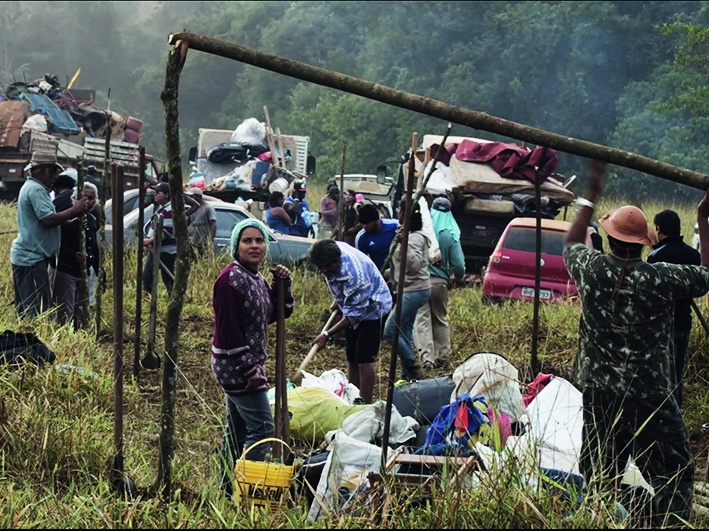THE COLONIAL LIVES OF PROPERTY, ABOLITIONIST STRUGGLES, AND ALTERNATIVE IMAGINARIES Brenna Bhandar in Conversation with Daniel Loick

Kader Attia, „Untitled (Skyline)“, 2007
With her book “Colonial Lives of Property: Law, Land and Racial Regimes of Ownership,” released in 2018, the writer and scholar Brenna Bhandar has made a vital contribution to the inquiry into the nexus between the historical evolution of the idea of property and colonialism.
In the following conversation with the philosopher Daniel Loick, she explains how land allocation in its juridical form was implemented using racist methods of dispossession, giving rise to a subjectivity grounded in power and entitlement that still informs Western superior thinking about ownership and property relations.
DANIEL LOICK: In property theory, property is often conceptualized as a universal, almost transhistorical concept, varying only in concrete ways of implementation. In fact, your book Colonial Lives of Property [1] is one of the very few major works investigating the colonial entanglements of the Western concept of property. Can you explain in general terms how the institution of property is related to colonialism, and what some of the contemporary effects of the entanglements of property and colonialism are?
BRENNA BHANDAR: Property law is one of the central motor forces of colonialism. As one of the primary means of seizing and asserting ownership over the land base of another people, property law was used to fundamentally transform the use and control of land and resources, and with that, the social relations, economies, and cultural practices that were imbricated with indigenous and existing forms of land use. In other words, the colonial assertion of control over foreign territory, and the assertion of colonial sovereignty over indigenous lands in settler colonies, was accomplished largely through the imposition of common law forms of private property ownership (and relatedly, in many places, the imposition of particular forms of taxation and revenue collection). Some of the contemporary effects of this entanglement of property law and colonialism can be traced in the very legal form of property itself; meaning, some of the contemporary articulations of property laws were forged through colonial encounters, even though this history may not be visible in an obvious way. Second, many post-colonies and settler colonial contexts alike continue to grapple with the profound inequalities that this system of property law produced.
LOICK: In your book, you describe how colonialism often works by way of a “racial logic of abstraction,” especially through procedures such as “title by registration,” in which a state keeps a register of land holdings that then serves as proof of ownership. Can you explain the importance of this process of abstraction, and how it works in the service of racialization and colonial appropriation?
BHANDAR: The racial logic of abstraction that I analyze in the book is a way of exploring how contemporary commodity forms of property are articulated with and through racial subjectivities. With the example you mention, we can see how an increasingly commoditized vision of land, which provides the basis for the development of the system of title by registration that is eventually enshrined in legislation that applies to the entirety of the UK in 1925, evolves most rapidly in the settler colonial context many decades prior to that. Specifically, the Torrens system is instituted in the colony of South Australia in 1858, and from there travels to the colony of British Columbia. This system was implemented in colonies where the land was considered to be terra nullius, owned by no one, on the basis that the indigenous inhabitants were not using the land in a way that reflected, in the eyes of the colonial settlers, a sufficient degree of civilizational advancement. The racial abstraction of the “native” or even “savage” is thus imbricated with the way a commodity vision of property takes shape in the form of a system of title by registration in the colonies. A key thing to remember about the effects of a system of title by registration is that it renders any prior ownership interests that are not registered in the state-held registry legally void. In many colonial contexts, indigenous people were either not entitled to register their interests (they were not recognized as legitimate owners, as explained above), or there were many bureaucratic and practical difficulties that prevented them from doing so. The imposition of a system of title by registration thus functioned in many colonies as a means of dispossessing indigenous peoples of their land, on the basis of a racial logic that rendered them non-owners in the first place.

„Lawrence Abu Hamdan: The Voice Before the Law“, Hamburger Bahnhof, Berlin, 2019/2020, Ausstellungsansicht / installation view
LOICK: You also underline the importance of commodification of land for this process of colonial appropriation, drawing especially on Cedric Robinson’s concept of “racial capitalism.” [2] But how much does your critique of property buy into the general Marxist critique that focuses mainly on a critique of private property in the means of production, leading to the exploitation of the workers? Would you say colonialism can be explained from within this Marxist framework, or is it itself bound up with its Eurocentric premises and therefore in need of revision or at least enrichment by other theoretical approaches (such as post- or decolonial theories)?
BHANDAR: I think the “general Marxist” critique of property is not a straightforward proposition. In my work, I draw on the work of the Soviet legal theorist Evgeny Pashukanis in order to develop a critique of the commodity form of real property, but in my view, this framework of analysis does not enable us to see how the colonial encounter was such a significant part of how modern laws of property developed, at least in the common-law world. As to how effective Marxist critique is in grappling with the specific nature of colonialism as it relates to the development of capitalism, I have found the early critique offered by the Subaltern Studies School theorists and some postcolonial critics very helpful in identifying and understanding the epistemological and ontological assumptions embedded within Marxist categories of analysis. We can think, for instance, of how the concept of “primitive accumulation” has been reconceptualized as a continually evolving process that did not end with the enclosure movement in the UK, and which continues to inform the struggles of First Nations in settler colonies against land dispossession, extractive industries, and real estate speculation as well as working class, racialized communities’ struggles against the ongoing theft of public space and public goods. The “general Marxist” critique of property doesn’t adequately contend with the racial and gendered dimensions of the form of ownership (private property) that lies at the heart of capitalist modes of accumulation. So, this is not so much a matter of whether Marx paid sufficient attention to slavery and colonialism in his work, but rather of how Marxist forms of critique of capital and capitalism are limited in various ways, including a broadly Eurocentric approach to understanding how capitalist modes of appropriation, exploitation, and production create the worlds we live in. The significant place of race and, relatedly, gender in the world-making processes, structures, and phenomena of colonial capitalism also requires a fundamentally different point of departure than most, if not all, Marxist critiques employ. Drawing on a hugely diverse range of thinkers, from Stuart Hall to Cedric Robinson to Hortense Spillers to Frantz Fanon, we can begin to think about how the production of race and racial subjects is intrinsic to capitalism, capitalism(s) which emerged through the specific institutions of transatlantic slavery and globalized colonial ventures.
LOICK: One central aspect of the racial structure of property is what kind of subjects it presupposes and produces, i.e., the question of what it means to be an owner. You draw on the work of Cheryl Harris, who in her seminal essay “Whiteness as Property” [3] explains how whiteness and property are based on the same social and cultural imaginaries, and how whiteness itself is a property-like feature, enabling discrimination, dispossession, and exploitation. Charles Mills, in his book The Racial Contract, [4] has in a similar vein shown how our understanding of the contracting individual is still marked by the subjectivity of the slave owner and works to uphold regimes of white supremacy. How can we understand the racial logic of the possessive individual in the context of colonialism?
BHANDAR: I will consider this question with reference to the specific context of settler colonialism. In many places, historically speaking, First Nations and immigrant settlers of color were either legally barred from owning property in fee simple (the strongest or greatest ownership right), or the preconditions for ownership were so onerous for First Nations and people of color that it was inaccessible. For instance, after the passage of the 1867 Indian Act in Canada, First Nations would have to give up Indian status, which was the precondition for having the right to reside on reserve lands, in order to become a fee simple owner of land. At the same time, legislation was passed to facilitate the appropriation and cultivation of land by white male settlers (and some white women under specific conditions relating to their marital status). We can see how inclusion in the body politic and the figure of the “proper” citizenship subject was shaped through relations of ownership that were in turn determined in part by racial and gender identities, forging the subjectivity of the possessive individual who bore the traits of whiteness and maleness. This subjectivity then takes on meaning in psychic-social and symbolic realms, with long-lasting legacies that shape forms of entitlement and social power even where these “structures of feeling” may not be subtended by actual ownership or economic wealth.

Luke Willis Thompson, „Adjacency (US v Slager)“, 2019
LOICK: So would you say then that we all, as citizens of European nation states, are still haunted by the affective legacies of this colonial and racialized subject formation?
BHANDAR: I’m reluctant to make such generalizations. For instance, I don’t know enough about German colonialism in Namibia and elsewhere to fully grasp how modern German land law was shaped through that colonial encounter. I would venture to say that it is likely impossible that its contours were not impacted, altered, transformed in some way by German colonialism in Africa. How did a racial regime of ownership emerge in Namibia, and what was its relationship to the genocide of the Nama, Herero, and San people? How did the genocide of people in Tanzania and other German colonies in East Africa, and the dehumanization of African peoples by German colonizers more generally, relate to the appropriation of their land? Aimé Césaire reminds us in Discourse on Colonialism [5] that the roots of fascism in Europe lie in colonialism. This history of German colonialism in Africa seems sorely understudied when we think about contemporary forms of dispossession, racism, and property relations in Germany. Racial regimes of ownership certainly emerge in the North African colonies of the French, in Algeria and Tunisia for instance. This history is undoubtedly related to the racial and spatial segregation of black and brown Parisians in the banlieues, as many scholars (and artists; I’m thinking here of Kader Attia’s work) have explored. And then, of course, there is the longer history of the European slave trade, which introduces a range of complexities when we consider the differing legal justifications for slavery and the processes through which slavery became racially codified. I suppose to get back to your question, yes, citizens of European nation states are most certainly affected, and shaped in ways that are not particularly visible to many people it seems, by the legacies of colonialism and slavery that continue right into the present. And these are not just “affective legacies” but are material to their core.
LOICK: Some other theorists have pointed out the problematic effects of property on our subjectivity, too. For example, Jacques Derrida has explored the xenophobic structure of the Western metaphysics of the “proper”; Roberto Esposito has deciphered the concept of the property-owning person as a strategy of immunization, shielding the subject from its communal burdens; Giorgio Agamben has investigated the ontological violence performed by the act of imperial appropriation; feminist thinkers such as Margaret Davies and Eva von Redecker have shed light on the patriarchal structure of the phantasy of control and sovereignty inherent to the fiction of ownership, and so on. All these critiques have developed corresponding alternative imaginaries of subjectivity and intersubjectivity, often guided by images such as the gift, theft, usufruct, trust, or care. At the end of your book, you also mention an “alternate imaginary of property,” one that “actively counters the ontological and epistemic traits of the self-possessive individual” (p. 196). Can you elaborate a bit on what this imaginary could look like?

Camila Freitas, „Chão“, 2019, Filmstill
BHANDAR: In the concluding chapter of the book, I gesture toward what an alternate imaginary of “property” could look like by referring to the work of Leanne Simpson, Avery F. Gordon, Robin D. G. Kelley, and others, all of whom draw on histories of resistance and refusal of commodity forms of ownership and their attendant forms of subjectivity. Leanne Simpson draws on Anishinaabe philosophy and political, cultural practices to show the reader how relations between people and land, water, and non-human life forms reflect a non-commoditized conceptualization of the world and our place in it. [6] Avery F. Gordon in The Hawthorn Archive [7] and Robin D. G. Kelley in Freedom Dreams [8] both draw on different moments of radical black political resistance in the aftermath of slavery to illustrate what non-individualistic, multi-racial, and communal forms of land use looked like. All of these and many other histories of refusal of individual private property ownership and the racial, colonial systems within which this type of property relation is embedded require us to reconsider our expectations of ownership and use. How might we think about ways of relating to things – be it land, the lived-built environment, urban space, water, plant life – that is not premised upon the ownership ideal? What kinds of changes would the privileging of common and social forms of use (rather than individual ownership) require of us in terms of how we relate to one another?
LOICK: Most property theorists, even if they are critical of the unjust distribution of wealth, cannot imagine such a society without property. You take a much more radical stance, advocating what you call, with Ruth Wilson Gilmore and others, “property abolitionism.” In what ways do you seek to imagine a radical restructuring of our economic and social relations, freed from the property form?
BHANDAR: Exactly, the idea of “property abolitionism” draws on the work of Ruth Wilson Gilmore and her conceptualization of “abolition geography.” [9] Gilmore, A. Y. Davis, and many other militant scholars have long been involved in the movement for prison abolition. The idea of “abolition” in these contexts, as I’ve understood it, requires a wholesale transformation in capitalist political economies and social relations in the movement toward the abolition of prisons. If we think about what Mike Davis termed “the prison industrial complex,” [10] and Ruth Wilson Gilmore’s magnificent work Golden Gulag, [11] we begin to appreciate how the prison system in the US and elsewhere is one part of globalized racial capitalist modes of expropriation and subjugation. So the concept of “prison abolition” doesn’t simply mean abolishing prisons, but means working and struggling for a transformation of society as the groundwork necessary to work toward the abolition of prisons. Angela Y. Davis is author of a book called Are Prisons Obsolete? [12] Prisons are obsolete in the sense that the massive expansion of incarceration has clearly not dealt with the ostensible social ills imprisonment is supposed to ameliorate, and prison abolitionists have worked tirelessly to denaturalize the prison and incarceration as inevitabilities. Abolition is about breaking down and getting rid of the political and economic conditions that make the current prison system viable, and that is what it means to “make prisons obsolete.” If we think about property abolition, it requires us to think about what a world beyond the norms, structures, and psychic-symbolic centrality of private ownership might look like, and what the preconditions for such a shift might be. What I’ve learned through a recently completed project, a book of interviews titled Revolutionary Feminisms, [13] is that abolition work begins with centering and recognizing the transformative work, a work of survival really, that exists around us, has always existed, and upon which we must build. For instance, temporality is a hallmark of the private property form. Each and every property interest must have a defined and recognizable temporal period. Can we think about how to undermine or subvert the temporality of property ownership, perhaps as it relates to the alienation of our labor, in the workplace? There are long and varied histories of people withholding their time (in relation to paid work), “wasting” time, slowing down, banking time in the form of mutual aid, etc. that are instructive here.

Camila Freitas, „Chão“, 2019, Filmstill
LOICK: I found it striking that the concept of the “commons” is absent in the book …
BHANDAR: This was in part because the final chapter is more tentative than conclusive on the matter of alternatives to “racial regimes of ownership.” I think some aspects of the idea of commoning, as developed in the work of Silvia Federici [14] for instance, also require, like the politics of abolition I just mentioned, major transformations in social relations and political economies as a part of moving toward the commoning of land and other resources. The struggle for alternate ways of using and relating to land, urban space, resources, etc. cannot be conceived of in isolation to other political struggles that are confronting the violence of racial, colonial capitalism. More concretely, I am interested, going forward, in thinking about the contact points between indigenous feminist theory that centers the presence of children and social provisioning in anti-colonial struggle and the work of Federici and others who see the transformation of socially reproductive labor (broadly defined) as central to the struggle for different ways of using land, producing food, and reproducing life. I think the “commons” discourse that I am interested in exploring must share some conceptual and practical ground with anti-racist, feminist struggles to create a more just world.
LOICK: Yes, especially since some indigenous/First Nations activists are critical of that concept, insisting that extracted/stolen resources should not be commonized but given back to indigenous communities. Do you see ways to avoid this dilemma?
BHANDAR: Your question provokes a series of other questions for me. The notion of the commons begs the question of whose commons? Do contemporary discourses of “the commons” escape from the very problematic concepts of “the public” within juridical frameworks that have always operated to the exclusion of racialized and other marginalized groups of people? How is it that the discourse of the commons is never provincialized in the same way First Nations’ struggles are? Examples of “commons” that involve subsistence food production, or the deprivatization of social utilities such as water, are very much context-specific and involve local communities. So the commons discourse also needs to be localized and particularized; ideas of the commons come out of particular places and are not universal in form or content. A second point to make is that this question of “commoning” resources versus “giving them back” to First Nations raises the profoundly important issue of indigenous sovereignty. If indigenous sovereignty is bound up with the same concept of sovereignty – and the property regime it presupposes – that lay at the heart of European settler colonialism, is it anti-colonial? Are anti-colonial sovereignty movements that are not anti-capitalist (in some fashion) truly liberation movements? Scholars such as Glen Coulthard [15] and Leanne Simpson would, I think, answer this with a resolute “no.” I think this is less a dilemma than a set of extremely challenging political questions, about the meaning of solidarity and how to build solidarity between First Nations and immigrant settler populations, and more practically speaking, what First Nations and indigenous control of land and resources means for anti-racist, feminist, anti-capitalist struggles, against the confines of a settler colonial state. It’s also important to remember that there is a vast amount of diversity and heterogeneity within First Nations and within indigenous political organizations, and that these struggles are not unrelated to non-indigenous political struggles but, rather, that there are long histories of “cross-contamination” between non-indigenous political struggles and indigenous political movements (and again I’d refer you to the work of Glen Coulthard on this issue).
LOICK: To push this point even further: What strategic consequences follow from a radical critique of property in general? For example, would you say that indigenous and colonized people can strategically use property claims (such as “This is our land,” or by identifying dispossession as “theft”), or does this amount to trying to dismantle the master’s house with the master’s tools? How is it possible to refuse colonial dispossession without presupposing a prior “property order” that colonialism is violating?
BHANDAR: This question has been addressed by scholars such as Robert Nichols in his recent book Theft Is Property!, [16] and in an earlier article by legal scholar Bradley Bryan, “Property as Ontology,” [17] among many others. I think with respect as to whether colonized people can strategically use property claims in order to refuse or resist colonial dispossession, there is no pure political claim that can be made. In other words, I don’t see how one can engage a legal apparatus of dispossession in terms that are wholly other to that legal apparatus. But this not just a matter of strategy. Making claims for land that are not bound by a colonial anthropology of what constitutes “aboriginal title” or what came prior to colonial settlement, on the one hand, and on the other, rejecting property forms that are racial and colonial in their very structure and form, requires a great deal of intellectual heavy lifting and ingenuity. And this means going through “the masters’ tools” [18] and coming out on the other side with something terribly and wonderfully different; it requires a deconstruction in its deepest sense but accompanied by a materialist drive for something that is alien to the private property form.
LOICK: Brenna, thank you so much for this conversation.
Title Image: Kader Attia, „Untitled (Skyline)“, 2007
Notes
| [1] | Brenna Bhandar, Colonial Lives of Property: Law, Land, and Racial Regimes of Ownership, Durham, NC 2018. |
| [2] | Cedric J. Robinson, Black Marxism: The Making of the Radical Black Tradition, Chapel Hill, NC: University of North Carolina Press, 2000. |
| [3] | Cheryl Harris, “Whiteness as Property,” in: Harvard Law Review, vol. 106, no. 8, 1993, pp. 1707–91. |
| [4] | Charles Mills, The Racial Contract, Ithaca: Cornell University Press, 1997. |
| [5] | Aimé Césaire, Discourse on Colonialism, New York: Monthly Review, 2000. |
| [6] | Leanne Betasamosake Simpson, As We Have Always Done: Indigenous Freedom through Radical Resistance, Minneapolis: University of Minnesota Press, 2017. |
| [7] | Avery F. Gordon, The Hawthorn Archive: Letters from the Utopian Margins, New York: Fordham University Press, 2017. |
| [8] | Robin D. G. Kelley, Freedom Dreams: The Black Radical Imagination, New York: Beacon Press, 2002. |
| [9] | Ruth Wilson Gilmore, “Abolition Geography and the Problem of Innocence,” in: Gaye Theresa Johnson/Alex Lubin (eds.), Futures of Black Radicalism, London: Verso, 2017. |
| [10] | Mike Davis, “Hell Factories in the Field: A Prison-Industrial Complex,” in: The Nation, February 20 1995, pp. 229–34. |
| [11] | Ruth Wilson Gilmore, Golden Gulag: Prisons, Surplus, Crisis, and Opposition in Globalizing California, Berkeley: University of California Press, 2007. |
| [12] | Angela Y. Davis, Are Prisons Obsolete?, New York: Seven Stories, 2003. |
| [13] | Brenna Bhandar/Rafeef Ziadah (eds.), Revolutionary Feminisms: Conversations on Collective Action and Radical Thought, London: Verso, forthcoming. |
| [14] | Silvia Federici, Revolution at Point Zero: Housework, Reproduction, and Feminist Struggle, Oakland: pm press, 2012. |
| [15] | Glen Coulthard, Red Skin, White Masks: Rejecting the Colonial Politics of Recognition, Minneapolis: University of Minnesota Press, 2014. |
| [16] | Robert Nichols, Theft Is Property! Dispossession and Critical Theory, Durham, NC: Duke University Press, 2019. |
| [17] | Bradley Bryan, “Property as Ontology: On Aboriginal and English Understandings of Ownership,” in: Canadian Journal of Law and Jurisprudence, vol. 13, no. 1, 2000, pp. 3–31. |
| [18] | See Gayatri Chakravorty Spivak at https://www.radicalphilosophy.com/article/planetary-utopias |
